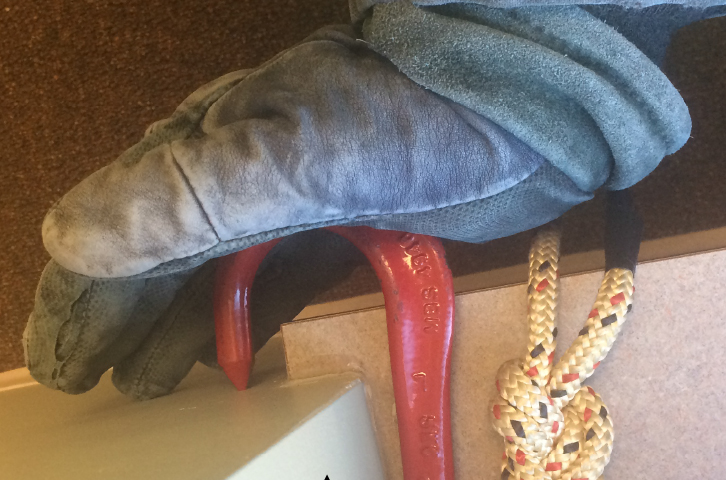

By Brian Zaitz
Scenario: You are conducting search on the second floor of an involved building when there is a sudden change in conditions: high heat with low visibility. Your egress point is blocked, and you must exit the structure. What is your plan? Do you have a system in place to effectively and safely exit the structure?
Many think this situation will not happen to them or, if needed, they will just jump to safety; this proves that a safety plan of “not happening to me” or “jumping” is no plan at all. The best solution to this scenario is a bailout system.
A bailout system is a personal escape system containing an anchor hook, rope, descending device, and a harness. Many systems are on the market, but all start with securing an anchor. As with any rope system, the anchor provides the strength and security for the entire descent. With bailout, there are three ways to secure the anchor point: hook in windowsill, remote anchor, or use of a tool.

If a firefighter finds himself in a situation and needs to immediately bail, he can deploy the hook from the system and place it into the windowsill while exiting the structure. The hook is held in place by hand until the firefighter exits and hangs out of the structure. The natural weight of the firefighter will pull tension on the system and set the anchor in place allowing the firefighter to descend from the window to a point of safety.
If time allows, the firefighter can use a remote anchor point; this is ideal when the firefighter has isolated himself in a bedroom with a closed door. The remote anchor provides a more secure method of anchoring by securing the hook and rope to a wall stud, a pipe, or a large piece of furniture. The idea here is not the “bomb-proof” anchor we would like to have in a rope rescue, but rather a sufficient enough anchor that will not move and provide for the quick descent of the firefighter. Again, this is only conducted when the firefighter has limited time to anchor remotely.

Another method of securing an anchor is to use a hand tool. Since we should always have a tool of some sort (a halligan, an ax, a hook, and so on), we can use that as an anchor by securing our tying the rope and hook around the tool and “setting” it into the wall. When setting the tool, the tool is driven into the wall with enough force to hold. However, it won’t hold enough to descend. For this reason, it is important to have the tool cross two sides of the window capturing two studs. The “setting” simply holds the tool once the firefighter begins to exit. The tension of the system will set the tool as an anchor against the studs, providing a secure descent.
RELATED: Seers on The Bailout Kit ‖ Dugan on the Staten Island Bailout ‖ Lipski on the Low Bailout Prop
Although we all hope it never happens, the reality is that any of us could find ourselves in a situation where we need to escape. The key is to have a system in place and adequate knowledge and training to be effective when the time comes. Take the time today to train on your system and practice bailouts in a safe environment. That way, if the time comes on a real incident, you will be ready.
Download this training bulletin as a PDF HERE (3.4 MB)
 Brian Zaitz is a 14-year student of the fire service, currently assigned as the captain/training officer with the Metro West (MO) Fire Protection District. Brian is an instructor with Engine House Training, LLC as well as instructor at the St. Louis County Fire Academy. Brian holds several degrees, including an associates in paramedic technology, a bachelors in fire science management, and a masters in human resource development. Brian is currently and accredited chief training officer and student of the National Fire Academy’s Executive Fire Officer Program.
Brian Zaitz is a 14-year student of the fire service, currently assigned as the captain/training officer with the Metro West (MO) Fire Protection District. Brian is an instructor with Engine House Training, LLC as well as instructor at the St. Louis County Fire Academy. Brian holds several degrees, including an associates in paramedic technology, a bachelors in fire science management, and a masters in human resource development. Brian is currently and accredited chief training officer and student of the National Fire Academy’s Executive Fire Officer Program.
MORE THROW BACK TO BASICS

